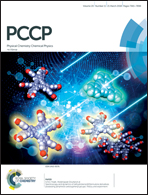Half-metallic and magnetic semiconducting behaviors of metal-doped blue phosphorus nanoribbons from first-principles calculations†
Abstract
We investigate the electronic and magnetic properties of substitutional metal atom impurities in two-dimensional (2D) blue phosphorene nanoribbons using first-principles calculations. In impure zigzag blue phosphorene nanoribbons (zBPNRs), a metal atom substitutes for a P atom at position “A/B”. The V-“B”structure shows half-metallic properties, while the Mn-“A/B”, V-“A”, Fe-“B”, and Cr-“A/B” structures show magnetic semiconductor properties. In addition, the Fe-“A” system shows magnetic metallic properties. On the other hand, for metal-doped armchair blue phosphorene nanoribbons (aBPNRs), the Mn-“A/B”, V-“A”, Fe-“A/B”, and Cr-“A/B” structures show magnetic semiconductor properties, while the V-“B” structure shows nonmagnetic properties. We find that the magnetic properties of such substitutional impurities can be understood by regarding the exchange splitting of the metal 3d orbitals. And from analyzing the electron orbitals, we conclude that the main contribution of the DOS for every system comes from the d and p orbitals. These results suggest excellent candidates for new magnetic semiconductors and half-metals for spintronic devices based on blue phosphorenes.



 Please wait while we load your content...
Please wait while we load your content...